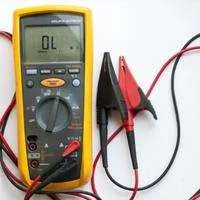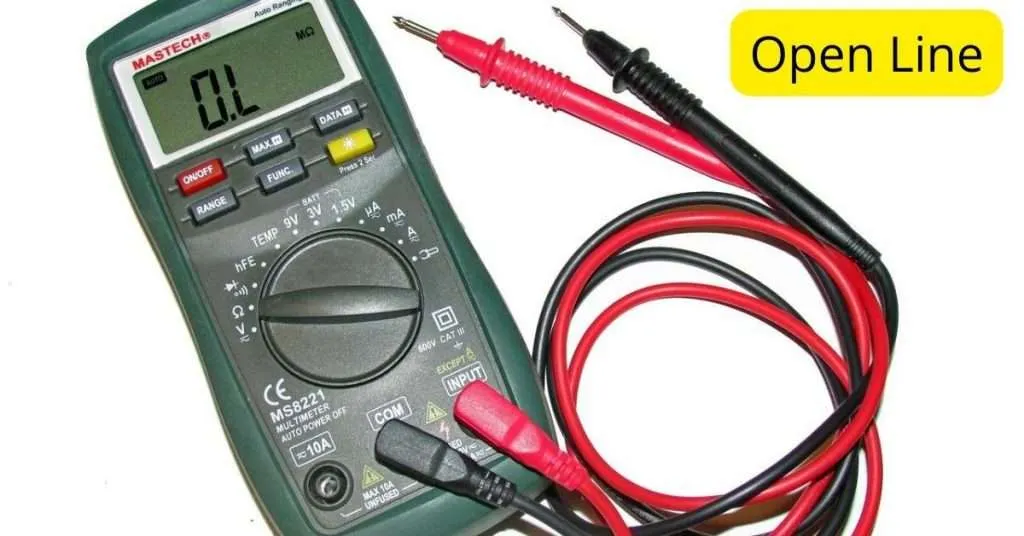If you are a student or beginner using a multimeter for resistance measurement, continuity test, or operating min/max function. You may have observed a strange reading on a multimeter that displays an OL sign, and you cannot figure out what OL means on a multimeter,
We will clarify what OL reading on a multimeter means. Let’s get started.
Table of Contents
ToggleWhat does OL mean on a multimeter?
OL on a multimeter stands for open line or open loop. It means the circuit is incomplete, and the current cannot flow in a complete cycle.
Whenever there is an incomplete or broken circuit, the multimeter will display OL because the current cannot flow in the loop.
It could be due to disconnected probes, damaged wires, or any faulty component in the tested circuit that hinders current from flowing from the multimeter battery to the tested part and back through the probes.
In a multimeter, current flows in the loop, and a non-continuous circuit always show one or OL on the multimeter due to an incomplete current flow path. Some multimeters also display OL as overload or over the limit when a circuit’s tested quantity exceeds the multimeter’s maximum limit.
Below we have discussed a few scenarios where an OL reading can be observed on a multimeter.
-
OL reading before attaching probes
Whenever a multimeter is turned on for a test until probes are not connected to a testing component, an OL reading is always displayed on the multimeter screen.
Because until the probes are in the air, there is a broken path for current flow. That is why the multimeter detects an open line and displays OL. The default setting gives OL reading every time in such a situation.
Remember, some multimeters will show one(1) instead of OL, but they both represent discontinuity(broken circuit).
OL reading in voltage test
While testing the voltage of a circuit, you may have seen an OL reading. When the wires in a circuit are broken, and the multimeter can’t detect any voltage passing in wires, it’ll show 1 or OL, which means an open or broken circuit.
Either the tested component has no continuity by default, or the circuit is broken. Make sure you’ve placed multimeter probes on the right spots, such as live and ground wires. Still, if your multimeter displays OL, the circuit wires are broken as the multimeter doesn’t detect voltage(current) passing in the loop.
Let’s take another example if you’ve set your multimeter to test voltage up to 20 volts. In comparison, the voltage in the tested circuit is quite high such as 240V. A multimeter will show OL, meaning the current is overloaded than the adjusted settings(out of range).
-
OL in continuity Test
Suppose you are examining a wire or any component for a continuity test. In that case, OL on a multimeter means that the circuit is not complete, and the current cannot flow through the conductor that is being tested. The circuit is incomplete, and that object fails the continuity test due to an incomplete path.
It could be due to several reasons, like the object you are testing is broken or expired, the probes are damaged, or the multimeter is not functioning correctly.
On the other hand, if the current is flowing from one probe to the object and then to another probe, the circuit is complete and will show 0 or the resistance of the conductor you are testing, depending on the functionality of your multimeter.
So a 0 reading in a continuity test means the circuit is complete and current is flowing entirely, and the continuity of the object is proved.
-
OL when measuring resistance
During resistance measurement, if the multimeter adjusted range is too low. The multimeter will show an OL reading because the resistor you are examining is beyond the multimeter limit.
Suppose you have set the multimeter limit to kilo ohm or below, and the resistance of the resistor is in mega ohm or higher. The multimeter will display OL, indicating overload. Another reason you may get an OL reading while measuring resistance is if the attached resistor is damaged or expired.
On the other hand, if the multimeter’s resistance range is higher than the resistor’s, the result will be 0. It means the measured resistance is approximately 0 compared to the multimeter limit.
0 ohm vs OL reading:
You may confuse the 0 and OL reading while measuring resistance as a beginner. If your multimeter reads 0 ohms, it means that the tested wire, conductor or circuit has the minimum resistance and is an excellent conductor. Your multimeter may show 0 without the ohm sign(Ω), but that doesn’t mean the circuit is broken.
Multimeter reading will fluctuate(up/down) while connecting probes to the circuit and stables at 0 ohms. While if the tested circuit doesn’t have continuity(open loop/broken), the multimeter will show a static OL or 1 sign.
However, if the tested conductor/circuit has quite high resistance that is out of your multimeter’s range, it’ll show OL.
-
OL reading in min/max function
You see OL while using the min/max function in the multimeter because the min/max button locks the range on the multimeter.
When you increase AC voltage above that limit, it displays an OL reading, which means the manual reading exceeds the limit. Thus min/max function shows an error. However, you can increase the limit on the multimeter with the Range button.
-
Damaged Multimeter
Suppose the multimeter continuously shows OL reading for a conductor. In that case, it could be due to a damaged multimeter or the probes. Try to check various devices to confirm if the multimeter is damaged.
Frequently Asked Questions
Does OL mean short circuit?
A short circuit occurs when an unnecessary component accidentally touches a circuit, and malfunction occurs. OL means an incomplete or broken circuit, displayed when the multimeter detects a broken circuit path by passing a current through wires to tested components back to the multimeter.
In this scenario, the current cannot flow in the loop, and the circuit is broken; thus multimeter displays OL meaning an open line.
What does OL mean on a Fluke multimeter?
OL on a fluke multimeter also means open line. While using a min/max function, if the voltage increases above the multimeter range, it shows OL.
In the other case, the Fluke multimeter will show OL if the circuit is incomplete and probes are unattached to an object. The conductor or resistor is under test or fails the continuity test. Fluke multimeter displays OL in the same scenario as other multimeters.
What does overload mean on a multimeter?
Except for broken circuits, the multimeter also displays OL when the tested electrical quantity of a circuit extends the maximum range of the multimeter. Such as if you are measuring voltage and adjusting a range to measure current between 0-400V, or your multimeter reads a maximum of 400 V.
In this scenario. If the current exceeds the adjusted limit, a multimeter will still display OL, which means an overloading current.
As we have discussed above, when a multimeter’s resistance mode is too low. For the measurement compared to the resistor to be tested, it will show OL. In this scenario, increase the resistance limit given on the multimeter dial.
What does OL mean on a megger?
A megohmmeter (Insulation resistance meter) displays OL, or I, which means overload. When the resistance of the device under test is beyond the maximum measurable limit of the megohmmeter, it will display OL.
Does OL mean short circuit?
OL means open loop or broken circuit path. However, a short circuit is a condition where a circuit’s wires touch each other and pass current randomly. A multimeter can detect broken circuit paths but can’t detect a short circuit.
The multimeter passes little power from its battery(cells) and checks if the current returns from the tested circuit. If the path is broken, the multimeter will show OL.
What does OL mean when testing a capacitor?
If your multimeter reads OL while testing a capacitor, it means that the capacitor is damaged and there is no continuity. However, if the tested capacitor/capacitance is out of the multimeter range, it’ll show OL, which signifies overload or over limit.
Conclusion
We have discussed every possible scenario where you may observe an OL reading on a multimeter or other electrical meters.
Hopefully, all your queries are solved regarding OL reading. If you still have any confusion, freely ask in the comments below.
Related Guides:






